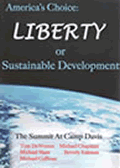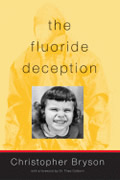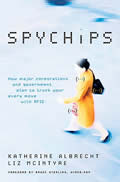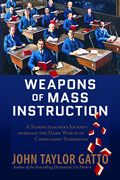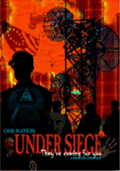"TAKING
THE RED PILL"
THE
REAL MATRIX
PART 11
By Professor
Steven Yates
August 5, 2014
NewsWithViews.com
The Higher Education Matrix (I)
“Only the educated are free.” ~Epictetus
“We must control education in the United States.” ~Carnegie Endowment for International Peace
“I'm trying to free your mind, Neo. But I can only show you the door. You're the one who has to walk through it.” ~Morpheus, The Matrix
High school seniors contemplating whether to attend college today confront a bewildering array of mixed messages. On the one hand, they are told that their employment prospects and income potential go up with a college degree. Depending on the degree, that might be true. On the other, though, the expense involved in getting that degree has risen beyond all reason. Federally guaranteed student loans may be easy to obtain, but come with a potentially enormous price tag: paralyzing debt that unlike other debt cannot be discharged in bankruptcy court if a good-paying job fails to materialize. A dearth of good-paying jobs has been the elephant in the living room of the Desert of the Real economy of recent years, however much the federal government, the Federal Reserve, and their loyal media bluster about the “economic recovery” and trot out Real Matrix statistics on unemployment (the BLS U-3 number, which only counts as unemployed those who aren't working and have applied for work in the past month). Many college graduates are not finding jobs that pay above minimum wage; some are not finding jobs at all, and ending up moving back in with Mom and Dad. This is one reason outstanding student loan debt now exceeds $1 trillion, exceeding outstanding credit card debt. Defaults on student loans are at an all-time high.
This problem—as will be obvious to longstanding readers of this series—didn't begin yesterday. It is hard to pin a start date on it.
The U.S. Constitution doesn't contain a word about education. There is no evidence its authors considered education a federal responsibility. Benjamin Rush, a signer of the Declaration of Independence, had expressed thoughts about what kind of education he deemed necessary for the success of the republic in the making. His suggestions won't make defenders of wall-of-separation arguments happy. He believed government should take charge of education and that the Christian faith should stand at its center; this was most likely to “render the mass of the people more homogeneous and thereby fit them more easily for uniform and peaceable government.” Rush's arguments, which predated the Convention of 1787 by one year, didn't gain traction.
I've recounted elsewhere (Ch. 2 of Four Cardinal Errors) how the U.S. fell into its ill-fated venture into public (government) schools, beginning with Horace Mann in the 1840s. Arguably, problems with higher education—traditionally aiming to produce the kind of intellectual elite able to guide a republic via extensive training in history, philosophy, theology, and classical languages (Latin and Greek), and reproduce itself generation after generation—begin a decade or so later.
The Morrill Act which would create the Land Grant system to teach agriculture and engineering was passed by Congress in 1859 but vetoed by President James Buchanan as unconstitutional. A new version incorporating teaching military tactics was passed in 1862. Abraham Lincoln signed this version as a wartime measure. “A & M” colleges sprang up across the country. A second Morrill Act was passed for Southern states in 1890. In all, around 70 new institutions were created, including historically black colleges. Classical education of the sort outlined above existed in these institutions, but was not their emphasis. This began the debate over whether higher education should emphasize classical learning or vocational training. Vocational training won out. Corporations wanted it; government saw advantages to it.
It is not as if humanities or liberal arts came under direct assault. The industrial revolution created an environment in which their role was thrown into doubt. It wasn't clear what they contributed to science. They didn't advance engineering or agriculture, or serve the military. Thus they didn't easily fit into the developing civilization, except as academic decorations. This was the state of affairs as the West entered the twentieth century, which did see subtle attacks on the intellect ranging from the Rockefeller-bankrolled Dewey school of thought known as “progressive education” to the increasing division of academia itself into specialized enclaves, academic departments (economics, political science, philosophy, etc.), whose members had their own jargon and could barely talk to one another.
The “analytic” tradition in Anglo-American philosophy was comfortable with having been warehoused in academia. It thrived in academic enclaves, addressing technical questions about scientific explanation and the ways in which language relates to the world. It did not see itself as “competing” with science. This is not to say its activities were unimportant. Quite the contrary. But that's another essay. When its members ventured into the political or socioeconomic arena, however, it was as private citizens, not professional philosophers. There were exceptions, but they were few and far between.
It was after World War II—interestingly the same decade which produced the corporatist global subversion machine we saw two installments back—that higher education seemed to enter a “golden age” which included academic philosophy. A flood of veterans entered universities on the GI Bill. This led to an abundance of new degree programs and faculty job openings to accommodate these new students. On the one hand, this was easily the best time in U.S. history to be a professor. For a time there was vigorous reading and learning. Intellectuals appeared with major works in their respective areas, sometimes for better and sometimes not. The point is, ideas were valued and provoked public conversation. Think of Joseph Schumpeter, Alfred Kinsey, David Riesman, C. Wright Mills, William Whyte, W.W. Rostow, Michael Young, and others. It was the era of the public intellectual, which continued on into the 1960s and shaped the mindset of the generation then coming up.
But on the other hand, American society embraced an idea that is fundamental false: Everybody Ought To Go To College. This was false because there always had been, and would continue to be, many good careers one could pursue that did not require a four-year degree. Not everyone is suited for college temperamentally, and society has always needed people who can work with their hands. But since many employers bought the idea, it became self-fulfilling. A university degree did allow one to rise in a profession and command a much higher salary than was possible otherwise.
The 1960s then gave us a very mixed bag! Perceptions of this decade are very much bound up with one's Weltanschaaungen. The 1950s had set the stage, with public conversation. In the 1960s, we saw civil rights legislation in response to stirrings that had begun during the earlier decade. We saw a shocking presidential assassination (JFK, obviously). We saw antiwar protests and heard rock music (often in combination). We saw bra-burners; we saw men with long hair, drug use, sexual liberation of all kinds (set loose by the mainstreaming of the Kinsey reports), environmentalism. We saw a great deal of idealism among college students with all levels of responsibility (from much to none at all). Scholars and students of mass media realized that furthering youth movements was the omnipresence of that new technology, television. It was bringing scenes from, e.g., the Vietnam War, into every family room in the country that had one, which by the mid 1960s was most of them. A generation decided, “We're not going to do this anymore!” Unfortunately, building constructive, positive alternatives is much harder than tearing down the old—even though Martin Luther King Jr. the public intellectual as well as activist had articulated some ideas in his speeches. He, too, was assassinated (1968).
During this period a European philosophical movement became influential: the Frankfurt School. Its membership, like that of the analysts, went back decades. Both groups had come to the U.S. fleeing the Nazis. The Frankfurt School had created the School of Social Research in Frankfurt, Germany—hence the name. As hard leftists, they had developed “cultural Marxism” under the realization that economic Marxism had failed. If they wished to “dethrone God and destroy capitalism” (as Marx had put it) they had to capture the culture and begin what Italian communist Antonio Gramsci had called a “long march through the institutions.” In other words, they had reached the same conclusions as the British Fabians, and set about to change institutions from the inside. Frankfurt School members established the New School of Social Research in New York City as their seat of activity. Higher education in the 1960s provided as fertile a ground as they would ever find. Herbert Marcuse, the school's most visible member, became the philosophical hero of the campus New Left. His philosophy combined Marx and Freud in books with titles like Eros and Civilization (1955) and One Dimensional Man (1964). His essay “Repressive Tolerance” (1965) had even more longstanding influence, arguing that free speech as protected by the First Amendment actually serves to reinforce the privileges of the dominant group (straight white men). Thus under “actual” social conditions, to achieve “real” tolerance it would be necessary to “repress” the views of this group and offer new privileges to blacks, women, and eventually gays. What would become known as political correctness was born. (Racial preferences also grew out of President Lyndon Johnson's famous “shackled runner” speech of 1964.)
Descriptions of what happened to higher education after 1970 are again almost a Rorschach test of one's worldview. Allan Bloom, Roger Kimball, Dinesh D'Souza and Thomas Sowell saw an enterprise that had lurched leftward, as New Left radicals went into teaching and administration, reshaping everything to fit their ideology. At one level, this is true. There is, however, more to the story, seen by peeling back the next layer of the onion. It helps also to read Noam Chomsky, Ian Mitroff, Cary Nelson, Sheldon Wolin, Benjamin Ginsberg, Michael Donaghue, and others for perspective. Corporatists were also acutely interested in what was happening on campuses, after all—because of their role in shaping the mindsets of entire generations and populations. The academic left was visible because it was sensational, as was the counterattack by the Allan Blooms and Dinesh D'Souzas—a counterattack that was proving futile for reasons that were mysterious to many of us at the time. It spoke the language of student revolutionaries who never grew up. They had hijacked their disciplines, creating a few new ones along the way (gender studies, critical race theory, queer theory, etc.). The corporatists were neither visible nor sensational. They spoke yawn-inducingly of balance sheets and bottom lines. They did not seek the limelight. They operated behind the scenes. They knew that is where the real power is.
For example, there was the much-discussed Powell Memorandum which went out in August 1971. It was aimed at the Chamber of Commerce, not the public. It called for the Chamber to lead big business in involving itself in higher education, to counter the New Left. Marcuse was among those Lewis Powell targeted by name. Another was Ralph Nader. Powell, who soon gained appointment to the Supreme Court, spoke the language of free enterprise. His own title, after all, was “Attack on the American Free Enterprise System.” I am not saying he was purposefully deceptive; I have no idea. There have been many people, in or around big business, who sincerely believed they were defending laissez faire, although the real thing is not fettered to, or dependent on, government except as a guarantor of rights and the rule of law. They lose sight that leviathan banks and other corporations are power centers no less than governments, motivated to control as well as to sell. One sentence from the Memorandum is suggestive: “We in America already have moved very far indeed toward some aspects of state socialism, as the needs and complexities of a vast urban society require types of regulation and control that were quite unnecessary in earlier times.” Powell quickly returned to the language of free enterprise, of course, but for careful readers the cat was just released from the bag.
I submit that a number of forces overwhelmed higher education beginning in the 1970s. Between them, they have largely destroyed it. What is left has the outward appearances of its ancestor, but is unable to produce properly educated, critically thinking Americans in sufficient numbers to yield a critical mass that understands and can place checks on power. In many cases, it is barely able to produce employable workers.
Powells's piece was widely circulated among wealthy businessmen. Some became university trustees. A few became university presidents. They corporatized their institutions from the top—transforming them according to the business model. Reduced government support for education during the troubled economy of the 1970s and early 1980s played into this strategy, as private funding stepped in. Students were treated as consumers and offered a smorgasbord of programs and subjects. Gone was the idea of an educated public as a public good. Instead, the emphasis was on students obtaining “job skills,” i.e., vocationalism on steroids. Faculty, likewise, were intended as servile workers, as in corporations. They could distinguish themselves most easily through publishable “research” that brought money into the school in the form of grants. Entire programs were created around “grantsmanship.”
Academic tenure did not fit this model. There is no such thing as tenure in the corporate world, after all. Thus it began to be phased out.
Helping to phase out tenure as well as create a more servile faculty was the collapse of the academic job market in the 1970s, especially in the humanities and social sciences which had been seen as repositories of troublemakers (and they were). This was a product both of the reduced support for higher education and a slightly smaller demographic of college students. The GI generation was gone, and Baby Boomers were tapering off. Graduate programs created in the 1950s and 1960s, however, continued to churn out Ph.D.s, who all of a sudden could not find academic work. In the 1980s we began to read about “cab-driving Ph.D.s.”
|
|
This set the stage for political correctness, the offspring of Marcuse's “Repressive Tolerance.” In the late 1980s and early 1990s, the market opened up again, slightly. Despite the corporatization of the university, those on the front lines in hiring decisions tended to be those whose heroes were Hegel, Marx, or Frankfurt School figures; or Darwin, Freud, or Dewey; or Simone de Beauvoir. They tended to hire ideological clones of themselves, and in accordance with newly emerged fashions such as the radical feminism of the week. Known dissidents were either weeded out or chose not to pursue academic careers. Thus the often-noted dearth of conservative intellectuals in academia. (There were and are a few libertarians whose economic philosophies tend towards pro-business conservatism minus its tendencies toward corporate welfare but whose personal philosophies were often indistinguishable from those of 1960s radicals: favoring so-called abortion rights, with rare exceptions rejecting Christianity, and sometimes defending the open borders mindset that has now created a severe crisis in the country).
To be continued.
Click here for part -----> 1, 2, 3, 4, 5, 6, 7, 8, 9, 10, 11, 12, 13, 14,
� 2014 Steven Yates - All Rights Reserved
Steven Yates has a doctorate in philosophy and currently lives in Santiago, Chile. He is the author of Four Cardinal Errors: Reasons for the Decline of the American Republic (Brush Fire Press International, 2011). He also owns an editing business, Final Draft Editing Service.
E-Mail: freeyourmindinsc@yahoo.com



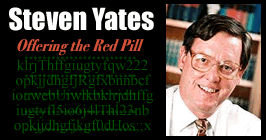


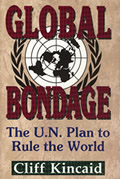

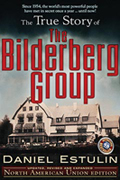
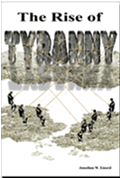
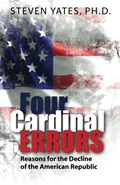




 Share
This Article
Share
This Article